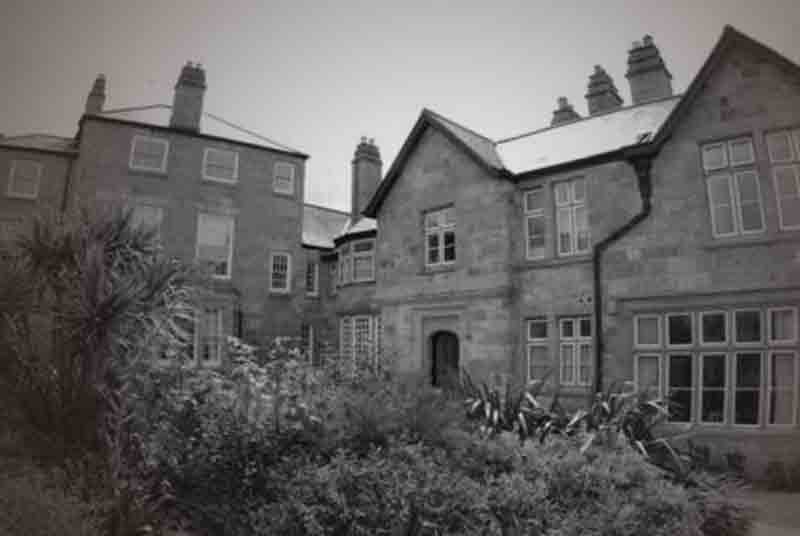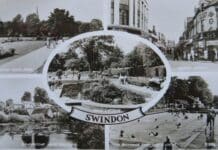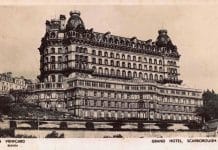Guest writer MATTHEW E BANKS reveals the haunted history of Kenegie Manor in Cornwall…

Kenegie Manor situated between Gulval and Penzance has a rich history having grown and prospered with changing family fortunes throughout the centuries.
It was originally the seat of a family of that name and the heirs married into the Tripcony family, who resided there until they became embroiled in the Cornish rebellion against King Henry VII. Tripcony was executed and the house confiscated by the Crown.
The name Kenegie means ‘mossy hedge’ or ‘house near the bogs’, though it could be derived from the Cornish word for rabbit, kyningen and it has been speculated that as the first recorded owners of Kenegie manor, the Tripcony family had on their coat of arms ‘Argent, three rabbits passant sable’ and it has been speculated that the name of ‘Kenegie’ has some relation to that name.
In 1948, Anne Pool contested that opinion and wrote, “It has been supposed by some Cornish historians that the name of ‘Tripcony’ has some connection with the name of Kenegie. This cannot be so, as we find it called ‘Kenegie’ before the time of the Tripconys, who were only in possession of it for about 60 years.” In 1570 a John Tripcony was vicar of nearby Gulval church.
It then passed to the Harris family of Heyne in Devonshire in the year 1600.
The family flourished under Elizabeth I and they greatly expanded the house. They were appointed Lieutenants of the County by Sir Walter Raleigh with responsibility for defending St Michael’s Mount in an age against Spain and France and later Harris was convicted for Royalists activities by Oliver Cromwell’s Parliamentary Forces.
The last male Harris died in 1775 and the bulk of the estate went by will to William Arundell, who was resident at Crane, in Camborne. He changed his name to Harris.
His grandson made his permanent residence at Lifton Park, near Launceston and sold his Cornish estates. Kenegie then became the property of Mr Thomas Ellis, a farmer who had been occupying it at a rent, though in 1814 Rose Price was the occupier.
The property was then sold to a London surgeon, Mr William Coulson, who in 1864 was sheriff of Cornwall. Coulson did much to restore the property, but in November 1866 sold the property to Mr Thomas Simon Bolitho for the sum of £17,500. Coulson died in 1886.
The Bolitho’s founded their fortune on tin and copper mining and did much to rebuild the house. There is a little mystery here, for at the entrance to the driveway, set a little way back is Kenegie Cradle.
It is a stone structure more or less of the shape as its name suggests and a little lower down from it, connected to the outer wall is a pillar that resembles a miniature Cleopatra’s Needle.
Originally the Cradle contained a wooden seat, but that has not survived. Because of its location, it isn’t that noticeable and for many years it was hidden by trees. No one seems to know when or by whom it was erected; nevertheless it is an interesting folly! The spirit of ‘Wild Harris’ has been sighted sitting here, looking out across the land towards the sea.
In 1954 Rowland Davis and his wife Ethal bought the manor and surrounding apartments and it became a holiday resort which are now either privately owned or part of the John Fowler Holiday Parks.
According to Bottral (who may have over romanticised) there are three ghosts that are known to have haunted Kenegie Manor and surrounding areas. One is of an old squire, known as ‘Old Harris,’ in his lifetime he made many alterations and additions to the manor and gardens, and was loathed to die and leave them. After his death he requested that on one certain night each year the front and back doors be left open for him to visit.
This custom was followed as the family feared misfortune if they did not comply, until the last member of the Harris family sold the Manor. It is said that Old Harris came to visit and finding the doors locked made an unearthly wailing noise and retreated to the family vault and was never seen again.
The Ghosts of Kenegie Manor
The next ghost was that of the housekeeper of a later squire, who became a favourite of her master, to the disapproval of the rest of the family. When the old squire died and the son became master he banished her from the house. She soon passed away and the very night after her funeral the disturbances started as her spirit returned to the manor where all sort of commotion was caused, wailing, crashing and footsteps running up the hall to the old masters room, could be heard.
The ghost of the woman was eventually confined to one room, in either the eastern or northern side of the house, and given the task of turning a black fleece white and knitting some stockings from it, and the doorway plastered over, so only a few knew of the room’s existence.
There have been reports over the years of a clicking sound, as though of knitting needles emanating in the house, but no-one has been able to find the source of the sound.
The last ghost is that of the young squire ‘Wild Harris’ who banished the housekeeper mentioned above. When alive he took a young penniless relative as his lover, his father and his favoured housekeeper disapproved, and the father said he would marry his house keeper before he let the young girl inherit any of his fortune.
The poor girl was treated as an intruder by the housekeeper, so she spent her time in the upper rooms of the summer-house with the older maidens of the Harris family. It appears that the ‘older’ Harris and the housekeeper were successful in separating the young couple and in despair the young girl wondered off one night and was found drowned the next morning in ‘Mill Pond’ Gulval.
Not long after the old squire died and the son became the new master and taking his revenge banished the troublesome housekeeper. Yet through his grieve, he became fixated on hunting and nights of revelry, keeping an open house for rich or poor alike, until one day he was thrown from his horse and killed.
It is said his horse was spooked by a white hare that frequently was seen following him and said to be the spirit of his young love. His body was taken to Gulval Church and laid to rest, but on return to Kenegie Manor the mourners saw the young Squire’s ghost standing in the summer house with his dog. It was said that his ghost with a dozen or more of his ‘old comrades’ would assemble on the bowling green or by the summer-house, where they were seen and heard talking, singing and having a raucous revelry that meant that few servants stayed long. It took the Reverend Polkinghorn of St.Ives, reputedly the most powerful exorcist west of Hayle, to lay the ghost of ‘Wild Harris’ after several others had failed in their attempts to do so. Reverend Polkinghorn set the spirit of ‘Wild Harris’ to work, counting every blade of grass at Castle-An-Dinas.
Rupert Matthews in his book Mysterious Cornwall tells of three ghosts that were haunting Kenegie when it was a hotel. It would appear that the Bolitho family sold the property around about 1920, and a woman in black has been sighted walking through the downstairs rooms, with a bunch of keys dangling from her waist. He states that judging from her dress she “might be from the 1860s.” A Mr Cocklin who owned Kenegie before it was sold as apartments ran the manor house as a hotel has gone on record to state that two of his guests, neither of whom had any knowledge of Kenegie’s history, had both entered the lounge on separate occasions and seen this figure and both descriptions tallied. Whether this apparition is the housekeeper of ‘Wild Harris’s time or some other later spirit is not known.
There is also an unseen spirit in the kitchen, where here attractive laugh is heard around the room when work is done. A maintenance man working by himself in the kitchen heard the laughter and described it thus; “not a woman, not a child, but a young girl.” Mr Cocklin related a story that a spacious room in Kenegie Manor that may have been a former dining hall, and which was now a lounge, had a reproduction portrait of Elizabeth I hanging on the wall. No matter how they hanged it, the portrait would later be found tilted to an angle of ten degrees. They could find no natural explanation for this, but this continued to happen each and every time that they straightened the portrait. Yet when they removed the portrait and replaced it with one of Henry VIII, the ‘tilting’ of the portrait ceased. Over time they tried to re-hang Elizabeth’s portrait, but it always ended up tilting. A visitor, knowing nothing of these events, spoke of feeling a powerful feminine presence in said lounge, coupled with the impression that it was someone who hated other women.
Mr Ian Green was the barman and one day he was in what was called ‘The Tudor Bar’ seated at a table, writing. The bar was closed and no-one else was in the room, yet something made him turn around and he saw the figure of a man dressed in brown standing by the fireplace (he only remembered the clothes – no other detail.) Going back to his writing, Mr Green turned a few times to see what the gentleman was doing, and on seeing that he had not moved continued with his writing. On turning around the fourth time, he found that the man had vanished. Mr Cocklin also stated that from another room he and his staff often heard the sound of voices asthough in conversation, but upon investigation found the room to be unoccupied.
Another ‘spirit’ that seems to have transcended the centuries is one entitled ‘the stroking ghost.’ Mrs Shirley Cocklin related her experience to the late Mr Eric Hirth:
“When we came here, the place was derelict and we were working round the clock to try and get it ready for opening as quickly as possible. One day I felt so exhausted that I went up to my room, undressed and got into bed. I think it was still daylight, but I am not sure. I must have drifted off to sleep because I remember waking upand seeing the door opening, then somebody or something came up to me and stroked my face, with the back of the hand, from my mouth to my ear. Then I imagine I turned over and went back to sleep. I gave the matter no further thought, thinking Chris had come into the room to see if I was asleep then gone out again.”
Sometime later, she was talking to some of the villagers of Gulval and one of them surprised her by mentioning that there was a ‘ghost who stroked your face’ and demonstrated to her what this apparition did and then she realized that she too had experienced this. She was also informed that when the manor had been requisitioned by the Cornwall War Agricultural Executive Committee as a hostel for agricultural workers (Land Girls) during the war, and several girls that were billeted there had experienced the same phenomena and that it was always the same story; a light, finger-tip pressure from mouth to ear, with the back of the hand, reminiscent of a ‘healing gesture.’
This was before the manor house was broken up and converted into apartments, and so if any of these occurances still happen, it is unknown, but in a 1967 edition of the Old Cornwall magazine they printed a letter dated from December 4th 1893 which adds much weight to Bottrel’s claims of ghostly happenings at Kenegie. Ms Maud Welman wrote to her Aunt Fannie her experiences and those of others that lived in the Manor House. She first recorded strange happenings in her diary for September 22nd 1880, stating that strange noises were being heard and upon investigation they could not find the source. This sound was heard by three different witnesses and Ms Welman goes on to state: “After that Autumn we were really never free from their noises. Sometimes it would be days or weeks before we heard anything and then one would be woke in the night by the door handles turning, saying “come in”; or one would hear footsteps coming down the passages and stopping apparently at one’s door.”
What rooms are haunted at Kenegie Manor?
There appear to be two particular rooms where the hauntings were particularly strong. Firstly, there was the Yellow Room where a nurse was heavily struck to her knee and much later two male servants gave up their ‘situation’ as they received blows to their knees also.
Though these physical attacks seem sporadic they fit in with the nasty housekeeper.
The other room where a ‘presence’ was felt and seen was the Pink room. A Blanche Pigott stayed in there in 1880 and was awoken suddenly. “At the foot of it (the bed) a young man watching me very fixedly [ ] he was very dark and seemed to have rather long hair … the whole thing disappeared in an instant.” That was the only time she saw anything, but slept badly in that room, felt there was a sensation of a ‘presence’ and she frequently heard breathing close to her. As with other guests, she too heard a constant walking up and down the passages. Another guest that stayed in the Pink room felt the same as Ms Pigott – that there was a ‘presence’ in the room that seemed to move close to the curtains and out of the door. It would appear that several witnesses, who stayed at separate times and were totally oblivious to each other informed Ms Welman of these occurrences and it was decided not to use that room. But on one occasion they were forced to do so.
The guests name was Leila and she distinctly felt someone leaning over her in bed and always had the feeling that someone was present in the room. Like previous guests that stayed in there she never slept well and was constantly waking up. She heard noises in the passages and on the stairs, yet she heard nothing in the room, only ‘felt’ it.
Then one night she had a terrible dream where someone entered her room and climbed into bed opposite her.
She stretched out her hand to reach for her match box and instead felt a cold hand trying to stop her from doing so! After a struggle she lit a candle and by the light of it she saw a pale face lying on the pillow. With this she awoke and was able to draw a picture of the face. Ms Welman concludes: “A certain ‘Wild Harris’ [ ] was ‘put to rest’ or ‘laid’, as they call it, in the part of the house now the ‘Pink Room’. There is also a legend of a housekeeper who haunted the rooms and gave people slaps; and this is curious considering the experiences of Lettice and Nurse Alice, of Reginald Glanville and of the footmen in the Downing’s service.”
A.K.Hamilton Jenkin confirmed this story in 1945 when he wrote: “Although their actual names must be withheld, there are persons still living who can confirm this. About forty years ago the Harris property passed into the hands of another well-knownCornish family, which was represented at that time by two ladies. The elder of these had retired to her bedroom one evening when her sister was much alarmed by suddenly hearing her terrified cries for help. Hastening to her room she anxiously inquired the cause of her distress. It was some time before the other became sufficiently composed to speak, but at length she stated that on being about to get into bed she suddenly perceived the face of a man outlined upon her pillow. Of this extraordinary story the younger sister appeared somewhat sceptical, and accordingly the other took up a pencil and proceeded to sketch the face which she had seen. So convincingly was this done that the writer’s informant, who had seen the drawing, had no more doubt than had the two ladies that the face was that of ‘Wilod Harris’, whose portrait remains for comparison with it to this day.”
Many times, the ghost of Wild Harris has been seen in the grounds of Kengie Manor and surrounding areas, wearing his hunting clothes. The summer house itself is a strange building. Bedrooms are at the bottom and living rooms at the top. During renovations a ‘coat of arms’ in black and gold was discovered, dating back (so I have been informed) to the 16th century. These appear on the other English coats of Arms for the Harris family. At the base of the coat of arms is a strange grinning face whose eyes appear to follow you around. The motto for the Harris of Kenegie was ‘Car Deu Reyz Pub Tra’ which means ‘Love God Above All.’
People staying there have found the bedrooms to always be very cold. The floorboards overhead creaks at night as though someone was walking on them, despite everyone being in bed and the doors and windows locked. One customer commented that her brother was awoken at 4am to the sound of a child running up and down over his room, despite no child being there and their dog sat at the end of the bed, gazing up. It has also been reported that there was a smell of matches and of a tall dark figure that is seen in the bedrooms, just at the corner of the eye. The summer house has a strange atmosphere about it and those that have the job of cleaning it like to do so as quickly as possible.
Another area of the estate that has a strange ‘haunted’ quality to it is The Old Forge, which is the bar / restaurant entertainment facility. Between the bar and the restaurant is a little ‘porch-like’ cut through – with the bar cellar to the right. Many times over the years dark shadowy shapes/ figures have been seen at the corner of the eye there. By the fire place there is a picture where every now and then a strange rancid smell appears – which is most unpleasant. Staff have reported to have felt as though they are being watched when alone or have a ‘feeling’ of being followed as they lock up for the night. Certainly, once the lights are turned off and you hurry out the atmosphere completely changes. Whether this is just nerves or something else is hard to tell.
Further to this several members of staff have reportedly seen a carriage coming down the drive and appears to stop outside the manor entrance, but when they have gone to investigate, the carriage has simply disappeared. Regardless, there has always been an idea in the village of Gulval that Kenegie Manor is haunted, and the Cornish historian Cyril Noall wrote that Kenegie Manor had been ‘one of the most haunted houses in Cornwall.’
Ghosts of Cornwall with Matthew Banks
MATTHEW E BANKS is a graduate of University of Plymouth. He lives in Cornwall with his wife Sam. Matthew’s main fields of interest are the supernatural in all its manifestations, horror film history and the ghost story genre.








The Tripcony estate was the farm behind